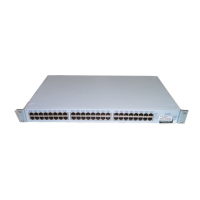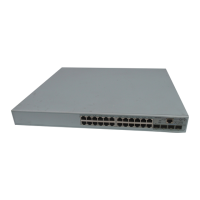32 CHAPTER 3: USING MULTICAST FILTERING
IGMP multicast filtering works as follows:
1 The IP router (or querier) periodically sends query packets to all the
endstations in the LANs or VLANs that are connected to it. If your
network has more than one IP router, then the one with the lowest IP
address becomes the querier.
2 When an IP endstation receives a query packet, it sends a report packet
back that identifies the multicast group that the endstation would like to
join.
3 When the report packet arrives at a port on a Switch with IGMP multicast
learning enabled, the Switch learns that the port is to forward traffic for
the multicast group and then forwards the packet to the router.
4 When the router receives the report packet, it registers that the LAN or
VLAN requires traffic for the multicast groups.
5 When the router forwards traffic for the multicast group to the LAN or
VLAN, the Switch units only forward the traffic to ports that received a
report packet.
Enabling IGMP Multicast Learning
You can enable or disable multicast learning using the Bridge >
Multicast Filtering > IGMP > snoopMode command on the Web
interface. For more information about enabling IGMP multicast learning,
please refer to the Management Interface Reference Guide supplied on
your Switch CD-ROM.
If IGMP multicast learning is not enabled then IP multicast traffic is always
forwarded, that is, it floods the network.
For information about configuring IGMP functionality on an endstation,
refer to the user documentation supplied with your endstation or the
endstation’s Network Interface Card (NIC).
How IGMP Supports
IP Multicast
IGMP provides a way for routers and switches to learn where group
members exist on a network, and thus provides a critical function in the IP
multicast packet delivery process.
Electing the Querier
On each subnetwork or broadcast domain (VLAN), the communication
between routers, switches, and group members begins with one
IGMP-capable device being elected as the querier - that is, the device that
asks all hosts to respond with a report of the IP multicast groups that they
